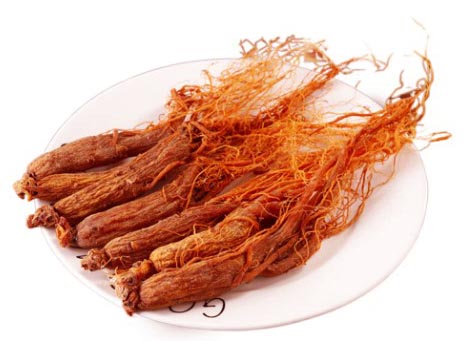Ginsenoside Rh2 from Red Ginseng reduces inflammation by blocking TLR4 dimerization and key immune pathways
Nikhil Prasad Fact checked by:Thailand Medical News Team Sep 03, 2024 1 year, 3 months, 1 week, 19 hours, 13 minutes ago
Herbs And Phytochemicals:
Ginsenoside Rh2: A New Hope for Reducing Inflammation
Researchers from Guizhou University and Jilin University in China have unveiled promising findings regarding Ginsenoside Rh2 (G-Rh2), a compound derived from red ginseng, that may significantly reduce inflammation. This
Herbs And Phytochemicals news report delves into the groundbreaking study, exploring how G-Rh2 interacts with critical immune pathways to provide anti-inflammatory effects, offering potential new avenues for therapeutic applications.
 Ginsenoside Rh2 from Red Ginseng reduces inflammation by blocking TLR4 dimerization and key immune pathways
Understanding Inflammation and the Role of TLR4
Ginsenoside Rh2 from Red Ginseng reduces inflammation by blocking TLR4 dimerization and key immune pathways
Understanding Inflammation and the Role of TLR4
Inflammation is a natural immune response, but when it becomes excessive, it can lead to various health problems. The immune system's Toll-like receptor 4 (TLR4) plays a crucial role in recognizing harmful substances, such as lipopolysaccharides (LPS) from bacteria. When LPS binds to TLR4, it triggers a series of reactions that lead to inflammation, often involving the dimerization, or pairing, of TLR4 with another protein called MD-2.
TLR4 dimerization is key to activating inflammatory signals, leading to the production of cytokines like tumor necrosis factor-alpha (TNF-α), interleukin-6 (IL-6), and nitric oxide (NO). While these molecules are vital for immune defense, their overproduction can cause harmful inflammation. The study focuses on whether G-Rh2 can interfere with this process to reduce inflammation.
G-Rh2: A Potential Blocker of TLR4 Dimerization
The study's authors, led by Shujuan Pan and Lu Wang from Guizhou University and Luyuan Peng from Jilin University, conducted a series of experiments to determine if G-Rh2 could block the dimerization of TLR4 and MD-2, thereby preventing the inflammatory response. The researchers first established that G-Rh2 is not toxic to RAW 264.7 cells, a type of immune cell used in the study. They then exposed these cells to LPS to trigger an inflammatory response.
The results were promising. G-Rh2 significantly reduced the secretion of TNF-α, IL-6, and NO in the LPS-stimulated cells, suggesting that it effectively inhibited the inflammatory process. The study reveals that G-Rh2 likely works by binding directly to TLR4 and MD-2 proteins, disrupting their dimerization and, as a result, blocking the subsequent activation of the TLR4/NF-κB signaling pathway, a major driver of inflammation.
Mechanisms Uncovered: How G-Rh2 Interacts with TLR4/MD-2
To further understand how G-Rh2 interferes with TLR4 dimerization, the researchers employed advanced techniques such as flow cytometry, fluorescent membrane localization, and molecular docking simulations. They discovered that G-Rh2 binds to specific sites within the hydrophobic pockets of TLR4/MD-2, effectively outcompeting LPS for these binding spots.
This bind
ing action was confirmed through surface plasmon resonance (SPR) analysis, which showed that G-Rh2 has a strong affinity for TLR4/MD-2, with a binding affinity (KD) of 71.20 µM. Although this affinity is lower than that of LPS, G-Rh2 was still able to disrupt the formation of the TLR4/MD-2 complex, thereby preventing the activation of downstream inflammatory signals.
Implications for Future Therapies
The study's findings suggest that G-Rh2 could serve as a novel therapeutic agent for inflammatory diseases. By targeting the initial steps of the inflammatory signaling pathway, G-Rh2 offers a different approach compared to current anti-inflammatory drugs, which often focus on reducing symptoms rather than preventing the underlying immune response.
The potential applications of G-Rh2 are vast, ranging from treating acute inflammatory conditions, like sepsis or inflammatory bowel disease, to chronic inflammatory disorders, such as rheumatoid arthritis. However, further research is needed to explore its efficacy in clinical settings and to understand the long-term effects of G-Rh2 treatment.
Concluding Thoughts
In summary, G-Rh2 has shown significant potential in reducing inflammation by blocking the TLR4/MD-2 dimerization and subsequent activation of the TLR4/NF-κB signaling pathway. These findings open up new possibilities for developing anti-inflammatory therapies based on G-Rh2, offering hope for patients suffering from a wide range of inflammatory conditions.
The study findings were published in the peer-reviewed International Journal of Molecular Sciences.
https://www.mdpi.com/1422-0067/25/17/9546
For the latest
Herbs And Phytochemical News, keep on logging to Thailand Medical News.
Read Also:
https://www.thailandmedical.news/news/herbs-and-phytochemicals-xanthones-from-hypericum-beanii-exhibit-potent-anti-inflammatory-properties
https://www.thailandmedical.news/news/taiwanese-study-finds-that-dihydrophenanthropyrans-from-pholidota-chinensis-alleviates-neutrophilic-inflammation-by-inhibiting-mapks
